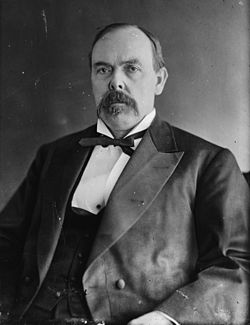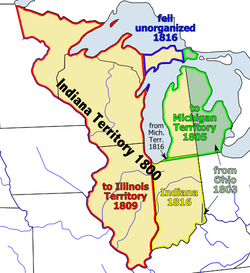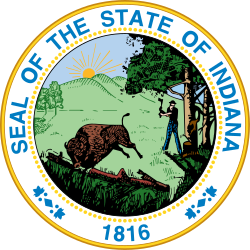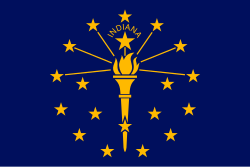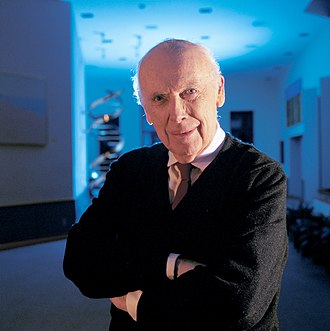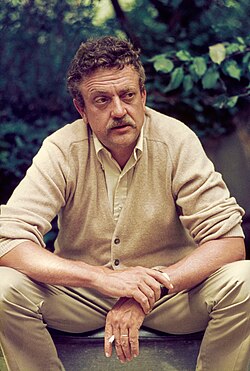The Indiana Portal
Indigenous resistance to American settlement was broken with their defeat in Battle of Tippecanoe in 1811, and the collapse the Tecumseh's confederacy in 1813. The new settlers were primarily Americans of British ancestry from the eastern seaboard and the Upland South, and Germans. After the Civil War, in which the state fought for the Union, natural gas attracted heavy industry and new European immigrants to its northern counties. In the first half of the 20th century, northern and central sections experienced a boom in goods manufacture and automobile production. Southern Indiana remained largely rural. After the rise and fall of the Klan in the 1920s, the state swung politically from the Republican to Democratic Party in the New Deal 1930s. Today, with a decades-long record of returning Republican majorities, Indiana is counted a "Red state".
Indiana has a diverse economy with a gross state product in 2023 of 404.3 billion. Indianapolis is at the center of the state's largest metropolitan area, with a population of over two million. The Fort Wayne metro area follows with a population of 645,000. (Full article...)
Selected article -
The Reno Gang, also known as the Reno Brothers Gang and The Jackson Thieves, were a group of criminals that operated in the Midwestern United States during and just after the American Civil War. Though short-lived, the gang carried out the first three peacetime train robberies in U.S. history. Most of the stolen money was never recovered.
The gang was broken up by the lynchings of ten of its members by vigilante mobs in 1868. The murders led to an international diplomatic incident with Canada and Great Britain, international newspaper coverage, and a general public uproar, though no one was ever identified or prosecuted for the lynchings. (Full article...)
Selected image -
 |
Did you know -
- ... that the Indianapolis African-American community raised $100,000 in just ten days in 1911 to establish the Senate Avenue YMCA?
- ... that after the Wolverines released their "Moose" for his fifth season, he went on to win another Big Ten championship with the Hoosiers?
- ... that the Circle Tower, an Art Deco building in Indianapolis, features ziggurat-like upper floors?
- ... that the existence of Lego Indiana Jones 2: The Adventure Continues was accidentally leaked when it was displayed on an animator's résumé?
- ... that viewers of an Indiana TV station's newscast in 1995 could send emails to the presenter live on air?
- ... that an "army" of women were congratulated by Pat Nixon for their fundraising efforts to bring public TV to Indianapolis?
Related portals
Selected geographic article -

Muncie (/ˈmʌnsi/ MUN-see) is a city in Delaware County, Indiana, United States, and its county seat. It is located in East Central Indiana about 50 miles (80 km) northeast of Indianapolis. At the 2020 census, the city's population was 65,195, down from 70,085 in the 2010 census. It is the principal city of the Muncie metropolitan statistical area, which encompasses all of Delaware County. The city is also included in the Indianapolis–Carmel–Muncie combined statistical area.
The Lenape people, led by Buckongahelas, arrived in the area in the 1790s. They founded several villages, including one known as Munsee Town, along the White River. The trading post, renamed Muncietown, was selected as the Delaware County seat and platted in 1827. Its name was officially shortened to Muncie in 1845 and incorporated as a city in 1865. Muncie developed as a manufacturing and industrial center, especially after the Indiana gas boom of the 1880s. It is home to Ball State University. Muncie was also the subject of the sociological Middletown studies, sociological research that was first conducted in the 1920s. (Full article...)
Selected biography -
Sherman "Shay" Minton (October 20, 1890 – April 9, 1965) was an American politician and jurist who served as a U.S. senator from Indiana and later became an associate justice of the Supreme Court of the United States; he was a member of the Democratic Party.
After attending college and law school, Minton served as a captain in World War I, following which he launched a legal and political career. In 1930, after multiple failed election attempts, and serving as a regional leader in the American Legion, he became a utility commissioner under the administration of Paul V. McNutt, Governor of Indiana. Four years later, Minton was elected to the United States Senate. During the campaign, he defended New Deal legislation in a series of addresses in which he suggested it was not necessary to uphold the United States Constitution during the Great Depression. Minton's campaign was denounced by his political opponents, and he received more widespread criticism for an address that became known as the "You Cannot Eat the Constitution" speech. As part of the New Deal Coalition, Minton championed President Franklin D. Roosevelt's unsuccessful court packing plans in the Senate and became one of his top Senate allies. (Full article...)
Selected quote
General images
Topics
- Economy: AM General - ATA Airlines - Casinos - Cummins - Delta - ITT - JayC - Lilly - Limestone - Manufacturing - NiSource - Shoe Carnival - Simon Property Group - Soybeans - Studebaker - Vectren - WellPoint
- Geography: Caves - Lakes - Rivers - State forests - Watersheds
Categories
Attractions
 |
Recognized content
| This is a list of recognized content, updated weekly by JL-Bot (talk · contribs) (typically on Saturdays). There is no need to edit the list yourself. If an article is missing from the list, make sure it is tagged or categorized (e.g. Category:WikiProject Indiana articles) correctly and wait for the next update. See WP:RECOG for configuration options. |
Featured articles
- 2005 United States Grand Prix
- Frank Borman
- William M. Branham
- Broad Ripple Park Carousel
- William Hayden English
- Benjamin Harrison
- John Hay
- USS Indiana (BB-1)
- Indiana-class battleship
- Janet Jackson
- Michael Jackson
- Harmon Killebrew
- Kenesaw Mountain Landis
- Lochry's Defeat
- Thomas R. Marshall
- On the Banks of the Wabash, Far Away
- Parks and Recreation season 1
- Pilot (Parks and Recreation)
- Ezra Pound
- Wiley Rutledge
- William S. Sadler
- Red Skelton
- John Gould Stephenson
- Tecumseh
- Battle of Tippecanoe
- WSNS-TV
- Warren County, Indiana
- Ryan White
- Wendell Willkie
Good articles
- 1925 tri-state tornado
- 1963 Indiana State Fairgrounds Coliseum gas explosion
- 2006 Brickyard 400
- 2008 Super Tuesday tornado outbreak
- Tornado outbreak sequence of June 3–11, 2008
- 2011 Brickyard 400
- 2011 South Bend mayoral election
- 2015 South Bend mayoral election
- 2019 South Bend mayoral election
- 2021 NCAA Division I men's basketball championship game
- 2022 College Football Playoff National Championship
- 2023 Robinson–Sullivan tornado
- Marcus Adams (Canadian football)
- Vic Aldridge
- Jeff Allen (defensive back, born 1958)
- Paul Bako
- Sean Bennett (gridiron football)
- Max Bielfeldt
- Blackford County Courthouse
- Blackford County, Indiana
- Donald Brashear
- Brown County State Park
- Sergio Brown
- Willa Brown
- Eric Bruntlett
- Pete Buttigieg
- Canvassing (Parks and Recreation)
- Castleton Square
- Hélio Castroneves
- George Rogers Clark
- Clark State Forest
- Levi Coffin
- Duesenberg
- Keith Elias
- Evan Bayh 2008 presidential campaign
- The Fault in Our Stars (film)
- Fort Wayne, Indiana
- Dario Franchitti
- Janie Fricke
- Crystal Gayle
- Hurley Goodall
- Governor of Indiana
- Gus Grissom
- Rex Grossman
- Caroline Harrison
- Harrison County, Indiana
- William Henry Harrison III
- Hartford City Courthouse Square Historic District
- Hartford City Glass Company
- Gabby Hartnett
- LaTroy Hawkins
- Howard Hawks
- Kelly Hecking
- Chris Hill (basketball)
- Thomas S. Hinde
- History of slavery in Indiana
- Lauren Holiday
- Hoosier cabinet
- Sam Hornish Jr.
- Otto Frederick Hunziker
- USS Indiana (BB-58)
- Indiana General Assembly
- Indiana Glass Company
- Indiana Governor's Residence
- Indiana in the American Civil War
- Indiana State Road 930
- Indiana Statehouse
- Indiana Territory
- Indiana World War Memorial Plaza
- Indianapolis Museum of Art
- Indianapolis in the American Civil War
- Indianapolis streetcar strike of 1913
- Inland Steel Company
- Interstate 469
- Rebbie Jackson
- Jonathan Jennings
- Tommy John
- Ezra Johnson
- James Jones (basketball, born 1980)
- Jim Jones
- Cato June
- Bob Kercher
- Ed Konopasek
- Lake James (Indiana)
- Earl Landgrebe
- Lieutenant Governor of Indiana
- Little Orphant Annie
- Kenny Lofton
- Carole Lombard
- Rami Malek
- Peyton Manning
- Mayoralty of Pete Buttigieg
- Karen McDougal
- Mary Harrison McKee
- Bo McMillin
- R. Ames Montgomery
- E'Twaun Moore
- Steve Morrison (American football)
- Oliver P. Morton
- Adrian Moss (basketball, born 1988)
- New Harmony Toll Bridge
- Northern cardinal
- Old Jeffersonville Historic District
- Joel Palmer
- Emma Reaney
- Tony Renna
- Richmond, Indiana, facility fire
- James Whitcomb Riley
- Oscar Robertson
- Ned Rorem
- Axl Rose
- Gunther E. Rothenberg
- Lou Rymkus
- Lou Saban
- Salesforce Marketing Cloud
- Germany Schulz
- Everett Scott
- Seal of Indiana
- Connie Smith
- Walter Bedell Smith
- South Shore Line Airport Realignment
- Brad Stevens
- Super Bowl XLVI halftime show
- Indiana Supreme Court
- Caleb Swanigan
- William S. Taylor (Kentucky politician)
- Thomas Trueblood
- U.S. Route 30 in Indiana
- University Park Mall
- Harold Urey
- Jacques Villeneuve
- WBAA
- WCAE
- Steve Wariner
- WDRB
- WFYI (TV)
- WGBO-DT
- Dan Wheldon
- WSJV
- WXIN
- WXIX-TV
Featured pictures
-
Baseball glass workers2
-
Carl Van Vechten - Shirley Graham Du Bois
-
GRESHAM, Walter Q-Treasury (BEP engraved portrait)
-
HARRISON, Benjamin-President (BEP engraved portrait)
-
HARRISON, William H-President (BEP engraved portrait)
-
Ida Husted Harper photograph by Aime Dupont
-
Indiana state coat of arms (illustrated, 1876)
-
James D Watson
-
Kenje Ogata 1943
-
Kurt Vonnegut by Bernard Gotfryd (1965)
-
McCULLOCH, Hugh-Treasury (BEP engraved portrait)
-
Midnight at the glassworks2b
-
Orville Wright 1905-crop
-
Pach Brothers - Benjamin Harrison
-
US-NBN-IL-Lebanon-2057-Orig-1-400-C
-
Vernon E. Jordan working on a voter education project
-
Wilbur Wright-crop
WikiProjects
State facts
Indiana | |
|---|---|
| Country | United States |
| Admitted to the Union | December 11, 1816 (19th) |
| Capital | Indianapolis |
| Largest city | Indianapolis |
| Largest metro and urban areas | Indianapolis-Carmel MSA |
| Government | |
| • Governor | Eric Holcomb (R) (2017) |
| • Lieutenant Governor | Suzanne Crouch (R) (2017) |
| Legislature | Indiana General Assembly |
| • Upper house | Senate |
| • Lower house | House of Representatives |
| U.S. senators | Todd Young (R) Mike Braun (R) |
| Population | |
• Total | 6,080,485 |
| • Density | 169.5/sq mi (65.46/km2) |
| Language | |
| • Official language | English |
| Latitude | 37° 46′ N to 41° 46′ N |
| Longitude | 84° 47′ W to 88° 6′ W |
Things you can do
 |
Here are some tasks awaiting attention:
|
Associated Wikimedia
The following Wikimedia Foundation sister projects provide more on this subject:
-
Commons
Free media repository -
Wikibooks
Free textbooks and manuals -
Wikidata
Free knowledge base -
Wikinews
Free-content news -
Wikiquote
Collection of quotations -
Wikisource
Free-content library -
Wikiversity
Free learning tools -
Wikivoyage
Free travel guide -
Wiktionary
Dictionary and thesaurus
- ^ a b "Elevations and Distances in the United States". U.S Geological Survey. 29 April 2005. Retrieved 2006-11-06.
{{cite web}}: CS1 maint: year (link)



